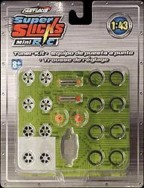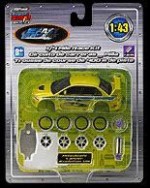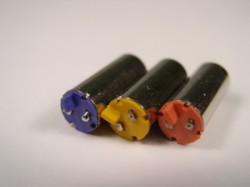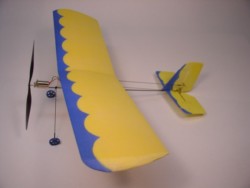
Super Slicks 7 MM Motors
By: Gordon Johnson, 5/1/2005
In May 2004 Greg Bacon (gbarc on RCGroups) discovered that a toy car at Toys R Us had a 7x17mm pager type of motor. It soon turned out that Toys R Us has an exclusive on what are called "Super Slicks" cars sold under the "Fast Lane" brand. To date no one has found these motors from any other source. The motors are available in cars and also in hop-up kits.
What makes these motors so special? First, they have a weight of 2.7g which is about 1.1g lighter than a typical M20-LV motor. They also have reasonably strong magnets and will attract objects to them. Not all coreless pager type motors have magnets this strong. The famous 4.5 ohm 6x12mm Didel pager was one of the first pager motors to show up with a stronger than average magnet.
Lastly, the motors are available in a variety of winds which makes matching the motor to a specific application a bit easier. What we have here is a pager motor that falls between a 6mm pager and an M20 in size and available in a variety of winds. The different winds are identified by the color of their end bell: green, orange, red, purple, light blue. The purple motor looks like a dark blue, but Super Slicks calls it purple.
Motor Constants Overview
I am a huge fan of my friend Joachim Bergmeyer's method for calculating motor constants. He wrote it up for the Inside Story column on the Ezone in February 2003 (http://www.rcgroups.com/links/index.php?id=4068). I would recommend that the interested reader peruse Joachim's article. I'll briefly review his method here. Understanding Joachim's method will form the foundation for subsequent articles on other families of motors, which I will analyze in the same way. The part of Joachim's method I like the most is going beyond just obtaining motor constants like Ri, Kv, etc. Using the values derived we can calculate performance values for the motor at any rpm. From here we determine the maximum power rpm and the maximum efficiency rpm and associated performance values. At this point we know quite a bit about how to use a given motor.
Let's go through some results to better understand this. The table below has two panels. The top panel gives predicted performance measures for each motor at its max power and max efficiency rpm. Amp draw is useful as it helps us choose a battery appropriate for the motor. Output power is given in watts. Efficiency is the ratio between input watts and output watts. When people refer to a motor's efficiency they are generally referring to its max efficiency. And, finally the motor rpm where max efficiency and max power are obtained is given. These motor rpm values are very important to us when evaluating static tests to determine what gearing and prop we want to use. We will want to prop a motor such that its rpm is below max efficiency rpm and above max power rpm. If we prop it below max power rpm we will actually obtain less power out and the motor may run too hot. In general for most planes we will want to try and gear and prop the motor to have a motor rpm near and somewhat higher than the max power rpm. There is no guarantee that at this rpm the motor won't run too hot. So, verifying that it is not running too hot is also a good idea. Coreless motors like the Super Slicks motors are not as good at dissipating heat as cored "can" motors like an M20 are. So, avoiding over heating these motors is a good idea.
The chart below has much useful information. Click on it to enlarge the data: (click once for partial enlargement. Click again on the expand symbol that pops up (four arrows) to get the chart to regular size).
Let's work through this framework for the orange and red motors. The red motor has a lower resistance than the orange motor so we know it will be a hotter wind and draw more current. The red motor's amp draw at max power of 0.69A compared to the orange motor's 0.49A verifies this. Efficiency at max power is essentially the same for both motors at about 46%. So, the red motor will put out more power in watts, nearly 40% more power, or 1.1W versus 0.8W for the orange motor. However the red motor develops its max power at a higher rpm, nearly 3,000 rpm higher. This means the red motor will either have to be geared higher or use a smaller diameter or lower pitch prop to achieve its higher max power rpm.
Static Tests
Now let's look at the static test results for the orange and red motors. The orange motor achieves its max power at about 14,000 rpm. I used Didel gears in gearboxes Carl Martin made for me for these tests. This means 3:1, 4:1, 5.3:1 and 6.7:1 were my only gearing choices. With a 5x3 prop and 3:1 gearing the orange motor is slightly over propped since the motor rpm is 13,230. At the next higher gear ratio of 4:1 it is under propped since the motor rpm is 18,120. The thrust is only slightly lower at 18g versus the lower 3:1 ratio's 19.3g. Amp draw is also lower at the 4:1 ratio at 0.43. This is within what the ET-90 and the Kokam 60 cells can deliver. So, if weight is an issue, as it usually is in micro planes, the 4:1 ratio might be a better choice. What this results in is a complete propulsion system consisting of motor/gearbox/battery that weighs less than many M20 based systems that require a heavier cell like the Kokam 145. The red motor develops its max power at about 17,500 rpm. The 4:1 gear ratio with the 5x3 prop again under props this motor. But, a substantially higher thrust is achieved of about 23g. Amp draw is higher so a larger cell like the Kokam 145 will need to be used if the plane will be flown near full throttle much of the time. If the plane will be flown at partial throttle with only occasional bursts of full throttle a Kokam 60mAh or either the E-Tec or Plantraco 90mah cells can be used to save weight.
The orange and red Super Slicks motors have been used by a number of people direct drive (DD). Ralph Bradley in particular knows a lot about DD in micro planes. In many cases he has found that starting with a prop like the GWS 2.5x1 or the Balsa Products 2.25x0.8 and then trimming it down and reshaping it results in a higher rpm and better pitch speed. I've done static tests of these props in untrimmed form and present them as a starting point. A good solution for a given plane may require a bit of trimming and reshaping till the right size prop is obtained. Overall we see that any of these props except the U80 is a good match with the orange motor in terms of the motor's max power rpm. The red motor develops its power at a higher rpm and these same props are slightly overpropping it. It may be that the prop will unload in flight and a higher rpm achieved. More likely, however, the prop will need to be trimmed. Overall it looks like between about 10g and 13g of static thrust can be obtained from these props DD. That said, static thrust for small DD props may not be as meaningful as it is for slower spinning larger geared props. Flight testing on any plane will be required.
The purple motor is hard to find and performs very similarly to the light blue motor. I'll concentrate on the light blue motor. The blue motor is currently the hottest wind of the Super Slicks motors. It develops its max power at about 23,000 rpm and has a predicted amp draw of slightly over an amp. This puts it on par with the M20-LV found in the KP00 and the Kenway gearboxes. The 4:1 gear ratio with the 5x3 prop results in a motor rpm almost exactly at max power rpm, and a very nice thrust of about 30g. However, amp draw is higher than predicted amp draw and the motor does begin to heat up. This combination may not have much longevity. It's hard to tell without performing stress tests. The higher 5.3:1 gear ratio with a 5x3 prop results in a motor rpm of almost 29,000 and is clearly under propping the motor. Thrust of 27g is lower as well. It would seem that a gear ratio of about 4.5:1 or 5:1 would be better for this motor.


Motors can be purchased in hop-up kits. The kit at the left contains two motors and the one at the right contains one motor and a car body.
Source of Super Slicks Motors
How do you obtain and use these motors? The motors can be purchased at Toys R Us stores. The cars used to come with a green motor, which was not sold separately. Now they seem to come with the orange motors. A hop-up kit containing one orange and one red motor costs about $8. The blue (and purple when you can find them) motors come in a hop up kit with one motor and a car body and cost about $10. They can also be purchased online from Toys R Us at http://www4.toysrus.com/superslicks/ss_info.cfm . Gearboxes are not so easy. Didel makes a 5:1 and 7:1 (really 6.7:1) gearbox for the 7mm motor. To obtain a 4:1 ratio you will need to make your own gearbox using a 48t spur gear and 12t pinion Didel gears.
Planes
There are a number of possible applications for the Super Slicks motors. A number of people are using them direct drive in Ralph Bradley's Mini Mite plane, in various sizes. Ralph is using a super slicks motor direct drive with a cut down prop in a Quick Junior. I recently made a variation on my Quick Junior design with longer wings, longer tail moment, huge 3D control surfaces, and a red Super Slicks motor geared 4:1 with a MCF 5x3 carbon fiber prop. This setup delivers about 23g of thrust, and with the light weight Plantraco Micro-900 receiver and their 90mah cell the total weight is 16g and the thrust to weight ratio is 1.3:1. This plane will loop on demand indoors and is a lot of fun to fly. The thrust and low overall weight contribute to this rather silly performance.
My latest Quick Junior uses the red Super Slicks motor to achieve 23g of thrust for a thrust/weight ratio of 1.3:1 in a 16g plane. It loops on demand and is a lot of fun to fly.
In conclusion, these motors are readily available. And, they are suitable for our micro RC needs. All that is required is making up your own gearbox unless using them direct drive. They are worth considering in your next micro project.


